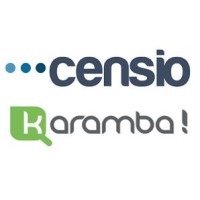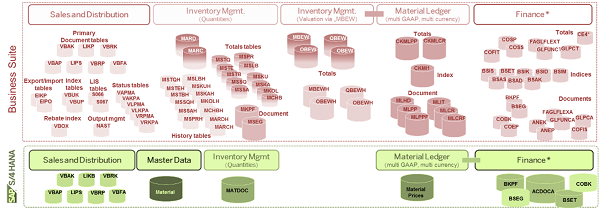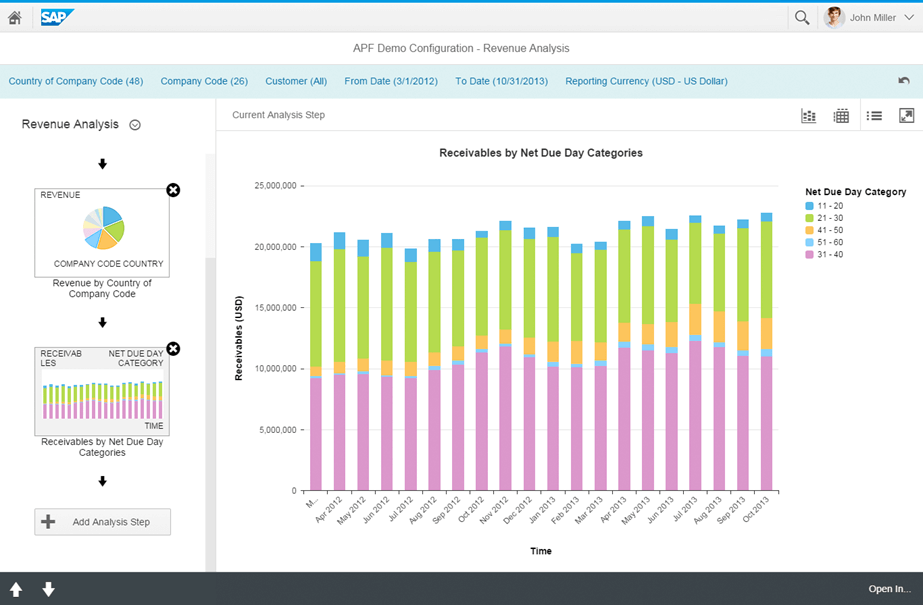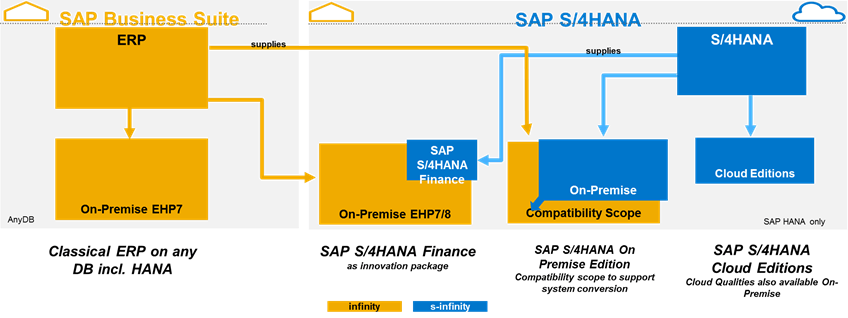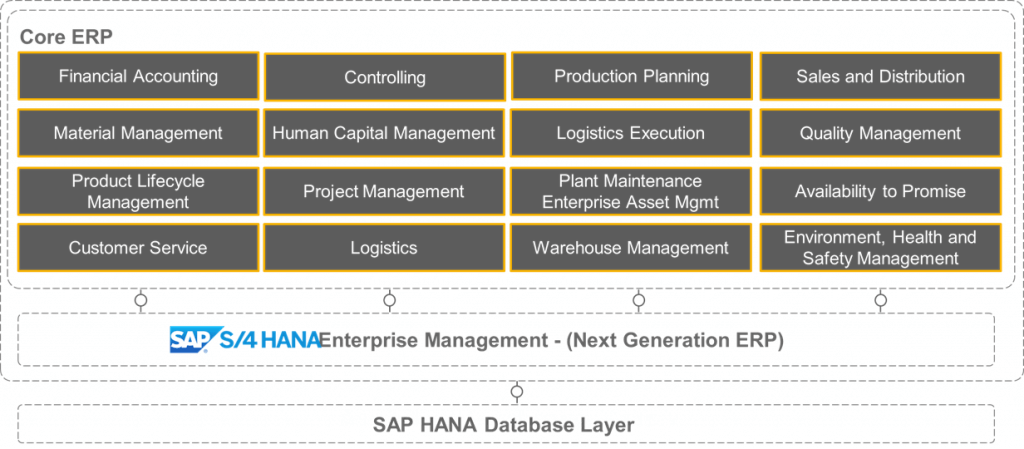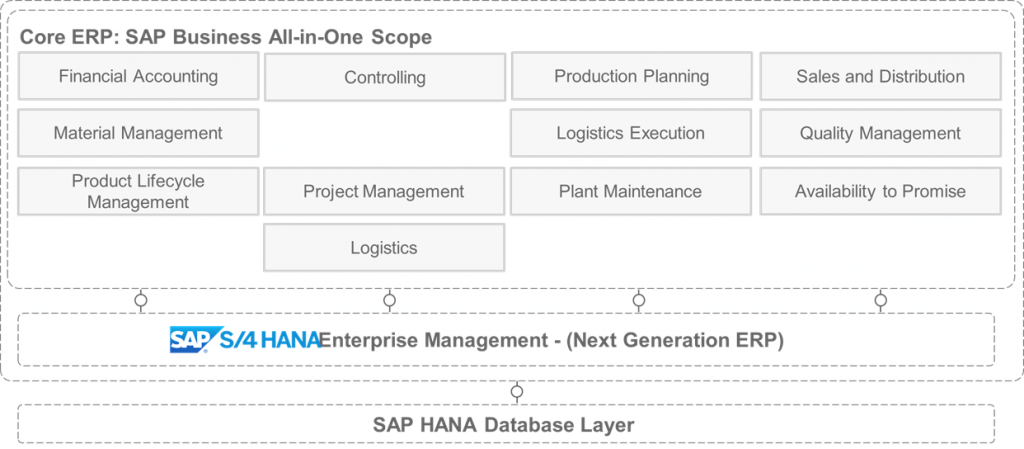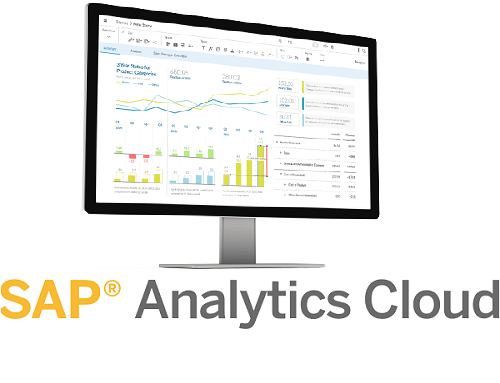SAP S/4HANA: Concepts
S/4HANA: SAP’s next generation of ERP
The second on premise version of S/4HANA (1511) was released in November 2015. It contains, of course, a slightly improved version of Simple Finance (or S/4HANA Finance) and the first version of Simple Logistics (or S/4HANA Material Management – Operations).
- S/4HANA is a complete and progressive rewrite of the ERP, based on the HANA platform only and non-disruptive
- Its scope is that of SAP Business Suite (ERP/CRM/SRM/SCM/PLM/BI/EPM) reintegrated into a single product (in progress)
- The data model has been simplified very substantially (drastic reduction in the number of tables)
- Performance is greatly improved > real-time BI, simulations, continuous closing, MRP on demand…
- The graphical interface is Fiori (more ergonomic, mobile, role-based)
- S/4HANA is available on premise or in the cloud (2 products with different perimeters / cycles of versions)
S/4HANA is built on the SAP HANA platform
- HANA replaces other databases (Oracle, Microsoft…)
- The “hot” data (e.g. current year) is stored in RAM, the data “cold” (and hot) on SSD (dynamic tiering)
- The size of the base is greatly reduced (factor 10, column model, compression, simplified data model…)
- HANA’s performance makes it possible to store no aggregates and calculate them on the fly
- OLTP/OLAP fusion (REAL-time BI on ERP through CDS views and BI4/Fiori, native drill down at the finest level)
- Complex calculations (MRP, CCR…), rewritten in SQL script, are performed within the database and no longer on the application server
- Multitenant (ECC – BW or several customers on a HANA comic)
S/4HANA centralizes data: Principle of One
This is the founding principle used in the design of S/4HANA and applies in all areas
- The information is stored only once, without redundancy (see Data Model Simplification)
- The technology platform is unified (HANA as the only database, disappearance of the JAVA stack…).
- The user interface is unique and meets unified standards (FIORI)
- The redundant features of the Business Suite are eliminated (Valo. MM > Ledger article, Four/Cli > BP, TRA > TM, SCM > ERP..)
S/4HANA simplifies the data model
The ERP data storage model has been completely redesigned and simplified.
- Only the lowest level of information (posts) is stored, aggregates are calculated on the fly
- Data from several modules have been merged into a single common table (e.g. FI-GL, FI-AA, CO, CO-PA, PCA, ML… See Simple Finance)
S/4HANA unifies end-user interface and delivers transactional decision-making
Fiori becomes the unified graphical interface of all SAP on premise and cloud solutions (or almost…).
The starting point for the user is the menu associated with his role and built tiles that lead to applications but also provide information (alerts, KPI’s, graphics …).
Fiori screens are roles-based, consistent, simple, mobile (responsive design) and based on HTML5 technology (SAPUI5).
They contain a mix of analytical info (graphics, tables…) transactional processes to move directly from information/alert to action.
They group the content of several transactions/reports directly or internally.
The number of FIORI applications is growing rapidly but does not cover the full perimeter of S/4. Menus sometimes call for Webgui transactions.
Apart from the new features developed with the help of Fiori, all S/4 business transactions remain accessible through SAPGUI.
There are transactional applications (which may contain analytic information).
And analytical applications to build “stories” with a principle similar to that of Lumira.
And of course, the data contained in S/4 can be quested through BI4 (Analysis for Office, Design Studio…) tools. or Lumira through CDSViews.
S/4HANA On Premise and S/4HANA Cloud: two possibilities
S/4HANA Cloud and On premise are two different solutions offered by SAP in terms of both perimeter and version cycle.
The S/4HANA Cloud versions will have a quarterly innovation cycle, while the one-premise version is expected to have an annual pace.
The covered perimeter is also very different.
The Cloud version contains only the perimeter of the features redeveloped for S/4, described as “Business All In One Scope” by SAP (in blue).
The On Premise versions contain both this redeveloped perimeter and the “compatibility scope” (in yellow) allowing to continue to cover the perimeter of the Business Suite (or at least that of ECC). This perimeter of old code should shrink as the versions go on and then disappear.
Version 1503 corresponded to the Business Suite on HANA – Simple Finance, while the 1511 contains a substantial redevelopment of the logistics field.
Above the perimeter 1511 on premise edition
Above the perimeter 1511 cloud edition

